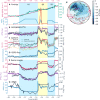Abrupt Heinrich Stadial 1 cooling missing in Greenland oxygen isotopes
- PMID: 34134984
- PMCID: PMC8208719
- DOI: 10.1126/sciadv.abh1007
Abrupt Heinrich Stadial 1 cooling missing in Greenland oxygen isotopes
Abstract
Abrupt climate changes during the last deglaciation have been well preserved in proxy records across the globe. However, one long-standing puzzle is the apparent absence of the onset of the Heinrich Stadial 1 (HS1) cold event around 18 ka in Greenland ice core oxygen isotope δ18 O records, inconsistent with other proxies. Here, combining proxy records with an isotope-enabled transient deglacial simulation, we propose that a substantial HS1 cooling onset did indeed occur over the Arctic in winter. However, this cooling signal in the depleted oxygen isotopic composition is completely compensated by the enrichment because of the loss of winter precipitation in response to sea ice expansion associated with AMOC slowdown during extreme glacial climate. In contrast, the Arctic summer warmed during HS1 and YD because of increased insolation and greenhouse gases, consistent with snowline reconstructions. Our work suggests that Greenland δ18 O may substantially underestimate temperature variability during cold glacial conditions.
Copyright © 2021 The Authors, some rights reserved; exclusive licensee American Association for the Advancement of Science. No claim to original U.S. Government Works. Distributed under a Creative Commons Attribution NonCommercial License 4.0 (CC BY-NC).
Figures



References
-
- Lynch-Stieglitz J., The Atlantic meridional overturning circulation and abrupt climate change. Ann. Rev. Mar. Sci. 9, 83–104 (2017). - PubMed
-
- Rahmstorf S., Ocean circulation and climate during the past 120,000 years. Nature 419, 207–214 (2002). - PubMed
-
- Alley R. B., Clark P. U., Keigwin L. D., Webb R. S., Making sense of millennial-scale climate change. Geophys. Monogr. Am. Geophys. Union 112, 385–394 (1999).
-
- Dansgaard W., Stable isotopes in precipitation. Tellus 16, 436–468 (1964).
-
- Böhm E., Lippold J., Gutjahr M., Frank M., Blaser P., Antz B., Fohlmeister J., Frank N., Andersen M. B., Deininger M., Strong and deep Atlantic meridional overturning circulation during the last glacial cycle. Nature 517, 73–76 (2015). - PubMed
LinkOut - more resources
Full Text Sources
Research Materials
Miscellaneous

